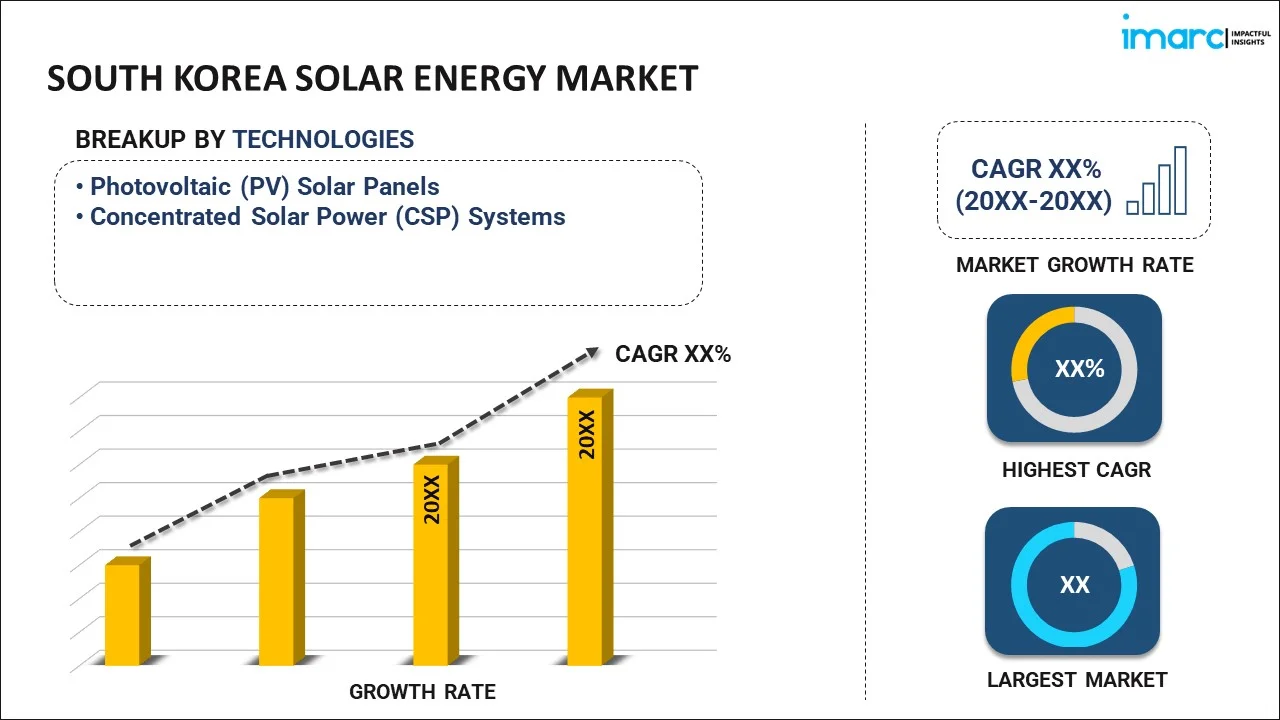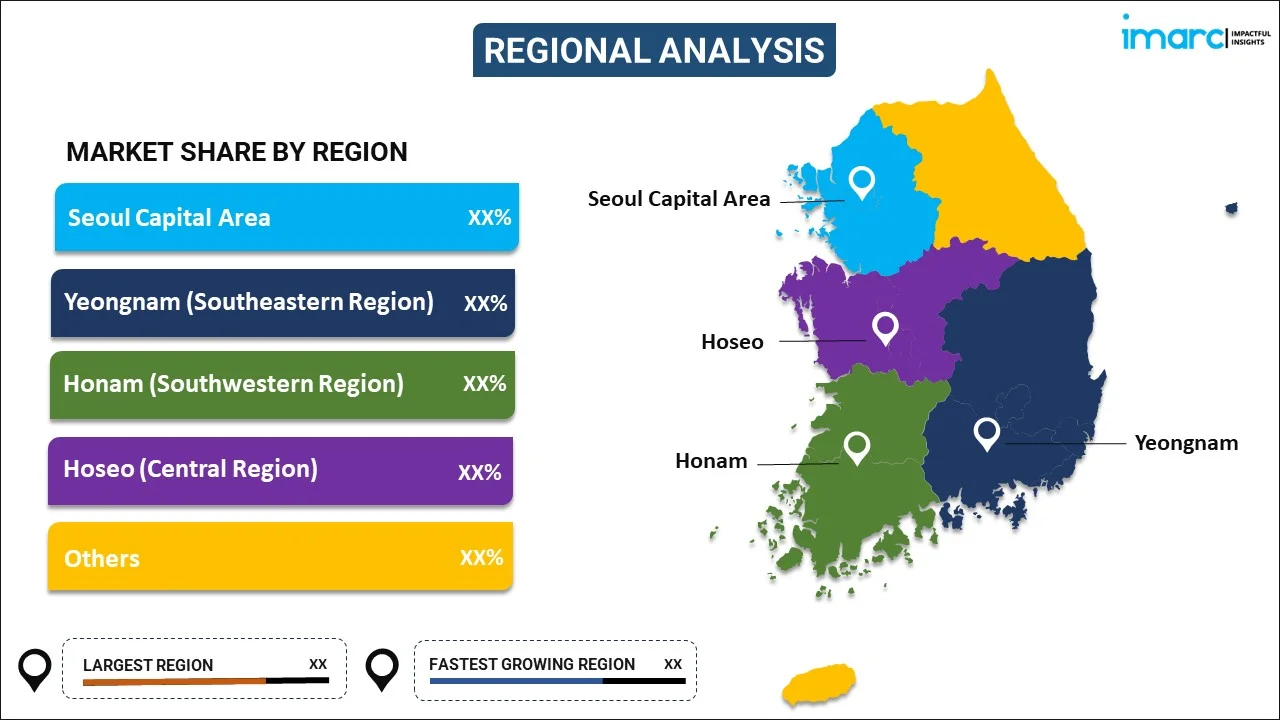
South Korea Solar Energy Market Report by Technology (Photovoltaic (PV) Solar Panels, Concentrated Solar Power (CSP) Systems), Application (On-grid, Off-grid), End User (Residential, Commercial, Industrial), and Region 2025-2033
Market Overview:
South Korea solar energy market size reached USD 2.3 Billion in 2024. Looking forward, IMARC Group expects the market to reach USD 6.7 Billion by 2033, exhibiting a growth rate (CAGR) of 11.2% during 2025-2033. Rapid expansion of different industries, rising partnerships and collaborations with international organizations and the implementation of favorable policies to promote the adoption of sustainable energy sources represent some of the key factors driving the market.
|
Report Attribute
|
Key Statistics
|
|---|---|
|
Base Year
|
2024
|
|
Forecast Years
|
2025-2033
|
|
Historical Years
|
2019-2024
|
| Market Size in 2024 | USD 2.3 Billion |
| Market Forecast in 2033 | USD 6.7 Billion |
| Market Growth Rate 2025-2033 | 11.2% |
Solar energy is a renewable and sustainable source of power harnessed from the radiant energy of the sun. It is captured through various technologies, such as photovoltaic (PV) cells and solar thermal systems, to generate clean and sustainable energy. It reduces greenhouse gas emissions, helping combat climate change by providing a clean alternative to fossil fuels. It allows individuals, businesses, and communities to generate their electricity, reducing dependence on centralized power grids and foreign energy sources. It is widely used to power irrigation systems, providing reliable water sources for farming, particularly in arid regions. Besides this, it can also be used in desalination processes to convert seawater into freshwater, addressing water scarcity issues. Moreover, as its production does not release greenhouse gases, pollutants, or harmful emissions, the demand for solar energy is increasing across South Korea.
South Korea Solar Energy Market Trends:
The expansion of various industries and a continuous rise in energy consumption represents one of the key factors influencing the market positively in South Korea. Solar power plants increase the energy supply, particularly during peak demand, help stabilize the grid, and reduce the risk of power shortages. Along with this, the reducing cost of solar technology is attracting businesses and homeowners looking to generate their electricity, further stimulating the market growth. Additionally, ongoing technological advancements are leading to improved solar panel efficiency, which is contributing to the overall cost-effectiveness of solar installations. Furthermore, governing authorities of the country are implementing favorable policies to promote the adoption of sustainable energy sources, which is creating a positive market outlook. They are also introducing a robust framework for permitting and interconnecting solar power systems, streamlining the process for project developers. Such regulatory support reduces barriers to entry and encourages investment in the sector. Moreover, ongoing innovations in energy storage systems, such as batteries, are enabling the efficient utilization of solar power by storing excess electricity generated during the day for use during nighttime or cloudy periods. These advancements are enhancing the reliability and versatility of solar energy installations, making them more attractive to residential and commercial sectors. In addition, various non-government organizations (NGOs) are actively promoting solar energy through educational campaigns, making citizens more aware about the benefits of solar power and its role in reducing energy costs and environmental impact. Along with this, rising partnerships and collaborations with international organizations for clean energy initiatives are attracting foreign investments and expertise, further advancing the solar energy sector. Moreover, rapid urbanization and the increasing construction of buildings are stimulating the market growth.
South Korea Solar Energy Market Segmentation:
IMARC Group provides an analysis of the key trends in each segment of the market, along with forecasts at the country level for 2025-2033. Our report has categorized the market based on technology, application, and end user.
Technology Insights:

- Photovoltaic (PV) Solar Panels
- Concentrated Solar Power (CSP) Systems
The report has provided a detailed breakup and analysis of the market based on the technology. This includes photovoltaic (PV) solar panels and concentrated solar power (CSP) systems.
Application Insights:
- On-grid
- Off-grid
A detailed breakup and analysis of the market based on the application have also been provided in the report. This includes on-grid and off-grid.
End User Insights:
- Residential
- Commercial
- Industrial
The report has provided a detailed breakup and analysis of the market based on the end user. This includes residential, commercial, and industrial.
Regional Insights:

- Seoul Capital Area
- Yeongnam (Southeastern Region)
- Honam (Southwestern Region)
- Hoseo (Central Region)
- Others
The report has also provided a comprehensive analysis of all the major regional markets, which include Seoul Capital Area, Yeongnam (Southeastern Region), Honam (Southwestern Region), Hoseo (Central Region), and others.
Competitive Landscape:
The market research report has also provided a comprehensive analysis of the competitive landscape in the market. Competitive analysis such as market structure, key player positioning, top winning strategies, competitive dashboard, and company evaluation quadrant has been covered in the report. Also, detailed profiles of all major companies have been provided. Some of the key players include:
- Hansol Technics Co. Ltd.
- Hanwa Group
- HD Hyundai Energy Solutions Ltd.
- OCI Company Ltd.
- Solarwindow Technologies Inc.
- Topsun Co. Ltd.
(Please note that this is only a partial list of the key players, and the complete list is provided in the report.)
South Korea Solar Energy Market Report Coverage:
| Report Features | Details |
|---|---|
| Base Year of the Analysis | 2024 |
| Historical Period | 2019-2024 |
| Forecast Period | 2025-2033 |
| Units | Billion USD |
| Scope of the Report | Exploration of Historical Trends and Market Outlook, Industry Catalysts and Challenges, Segment-Wise Historical and Future Market Assessment:
|
| Technologies Covered | Photovoltaic (PV) Solar Panels, Concentrated Solar Power (CSP) Systems |
| Applications Covered | On-grid, Off-grid |
| End Users Covered | Residential, Commercial, Industrial |
| Regions Covered | Seoul Capital Area, Yeongnam (Southeastern Region), Honam (Southwestern Region), Hoseo (Central Region), Others |
| Companies Covered | Hansol Technics Co. Ltd., Hanwa Group, HD Hyundai Energy Solutions Ltd., OCI Company Ltd., Solarwindow Technologies Inc., Topsun Co. Ltd., etc. |
| Customization Scope | 10% Free Customization |
| Post-Sale Analyst Support | 10-12 Weeks |
| Delivery Format | PDF and Excel through Email (We can also provide the editable version of the report in PPT/Word format on special request) |
Key Questions Answered in This Report:
- How has the South Korea solar energy market performed so far and how will it perform in the coming years?
- What has been the impact of COVID-19 on the South Korea solar energy market?
- What is the breakup of the South Korea solar energy market on the basis of technology?
- What is the breakup of the South Korea solar energy market on the basis of application?
- What is the breakup of the South Korea solar energy market on the basis of end user?
- What are the various stages in the value chain of the South Korea solar energy market?
- What are the key driving factors and challenges in the South Korea solar energy?
- What is the structure of the South Korea solar energy market and who are the key players?
- What is the degree of competition in the South Korea solar energy market?
Key Benefits for Stakeholders:
- IMARC’s industry report offers a comprehensive quantitative analysis of various market segments, historical and current market trends, market forecasts, and dynamics of the South Korea solar energy market from 2019-2033.
- The research report provides the latest information on the market drivers, challenges, and opportunities in the South Korea solar energy market.
- Porter's five forces analysis assist stakeholders in assessing the impact of new entrants, competitive rivalry, supplier power, buyer power, and the threat of substitution. It helps stakeholders to analyze the level of competition within the South Korea solar energy industry and its attractiveness.
- Competitive landscape allows stakeholders to understand their competitive environment and provides an insight into the current positions of key players in the market.
Need more help?
- Speak to our experienced analysts for insights on the current market scenarios.
- Include additional segments and countries to customize the report as per your requirement.
- Gain an unparalleled competitive advantage in your domain by understanding how to utilize the report and positively impacting your operations and revenue.
- For further assistance, please connect with our analysts.
 Inquire Before Buying
Inquire Before Buying
 Speak to an Analyst
Speak to an Analyst
 Request Brochure
Request Brochure
 Request Customization
Request Customization




.webp)




.webp)












